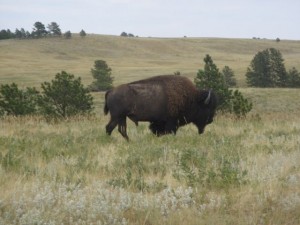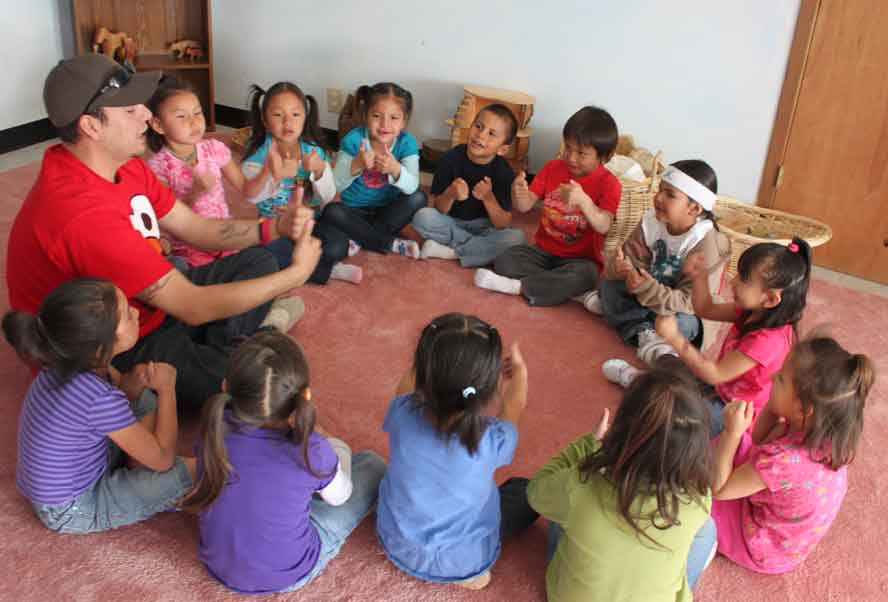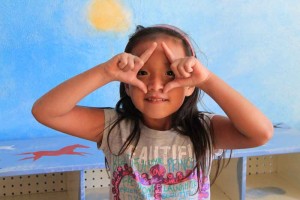Waldorf News
The Lakota Waldorf School: Our children must walk with the Lakota language and Lakota way of life

“Let us put our minds together to see what life we can make for our children.” –Chief Sitting Bull
South Dakota is the land of the great Lakota Nation. The Pine Ridge Reservation, home of the Oglala (Scatter Their Own) Lakota Sioux Tribe, is one of nine Indian reservations in the state and the home of approximately 40,000 Oglala Lakota. The Pine Ridge Reservation is situated within Shannon County where the per capita income makes it the second poorest county in the US with an average annual income of $3,700.00 and an unemployment rate of over 80%. Residents suffer from serious illnesses; diabetes, heart disease and chronic health conditions occur at levels vastly disproportionate to the national average. The life expectancy rate on the reservation is 48 years for men and 52 years for women. The school dropout rate is over 70%; the incidence of teen suicide is 150% above the national average. Even in 2011 there are still residents on the reservation without plumbing, kitchen facilities and electricity.
Despite these harsh conditions, poverty and suppression, the Lakota people still proudly live a rich culture, work toward maintaining the cultural heritage and toward the revival of their language. Nowadays only about 4% of the Lakota are fluent Lakota speakers and most of these speakers are over 50 years old. Their language will disappear if schools don’t start with immersion programs implementing the Lakota language into the curriculum.
 The Lakota Waldorf School was founded in 1992 by a group of Lakota parents committed to an alternative vision for their children’s education – one that included traditional Lakota values. The founders were John Around Him, Robert Stadnick, John Haas, Richard Moves Camp, Saunie Wilson and Norman Under Baggage. The school is located near Kyle, South Dakota, a community in the middle of the Pine Ridge Indian Reservation, in the Pejuta Haka (Medicine Root) District, one of nine districts that comprise the Pine Ridge Reservation. The Lakota Waldorf School is a pilot initiative; it is the only Waldorf School on a Native American reservation and offers the children assimilation of traditional Lakota language and culture through the Waldorf curriculum and teaching approach.
The Lakota Waldorf School was founded in 1992 by a group of Lakota parents committed to an alternative vision for their children’s education – one that included traditional Lakota values. The founders were John Around Him, Robert Stadnick, John Haas, Richard Moves Camp, Saunie Wilson and Norman Under Baggage. The school is located near Kyle, South Dakota, a community in the middle of the Pine Ridge Indian Reservation, in the Pejuta Haka (Medicine Root) District, one of nine districts that comprise the Pine Ridge Reservation. The Lakota Waldorf School is a pilot initiative; it is the only Waldorf School on a Native American reservation and offers the children assimilation of traditional Lakota language and culture through the Waldorf curriculum and teaching approach.
Wakanyeja unkitawapi ki Lakoliyapi na Lakol ounyanpi ki yuha manipi kte heca.
Our children must walk with the Lakota language and Lakota way of life.
Isabel Stadnick, administrator, and Tabor White Buffalo, kindergarten teacher took time recently to tell us more about the Lakota Waldorf School in their own words.
How did you come to teach at the Lakota Waldorf School?
TWB: This is my second year here. I am the Kindergarten teacher and there are 18 children. I teach with an assistant, Amaris Around Him. Before this I taught sixth grade at the District School in Wounded Knee, here on the reservation. I love kids and fell in love with teaching right from the start. I was looking for something different than the public school and I knew Isabel and a little about the Waldorf school. I built a corral and a fence around the property at her house. She encouraged me to apply and I’m very glad that I did. I saw so many connections between Rudolf Steiner, Waldorf education and Lakota culture. Head, heart and hands – that’s spot on with Lakota culture. We encourage our own children to experience the world and work with it. We guide them, but we don’t stop them from experiencing the world for themselves.
IS: I am Swiss and in 1989 I went on a three-week trip to South Dakota. We toured the reservation, stayed in teepees and lived with Lakota families. Our group leader was Bob Stadnick. It was my first visit and I had always been fascinated with the Indian culture. Two months later I married Bob and ended up staying on the reservation. Our three children were born between 1990 and 1996. I became immersed in the Lakota culture and life and we started to talk about a school based on the culture and language of the Lakota.
It arose organically out of cookouts, brainstorming sessions, and study together. We had to decide what educational model would fit our picture. My husband Bob and others in the Oglala Tribe knew about Rudolf Steiner’s work. In 1992 a group of Oglala travelled to Dornach, Switzerland to learn more about Waldorf education.
 We met with the Dr. Heinz Zimmerman, who was head of the Pedagogical Section at that time. Our question was, “Would there be a way to have a school that would fit our Lakota values and culture?” Dr. Zimmerman was enthusiastic and told us that it would have to embrace our own culture and language or it wouldn’t be a Waldorf School. Wherever the school is located makes a great influence on the children, the school and the community. This was a wonderful time for all of us. We stayed in Europe for a while longer and visited schools and communities and told our story of a search for a new way of education for the children at Pine Ridge.
We met with the Dr. Heinz Zimmerman, who was head of the Pedagogical Section at that time. Our question was, “Would there be a way to have a school that would fit our Lakota values and culture?” Dr. Zimmerman was enthusiastic and told us that it would have to embrace our own culture and language or it wouldn’t be a Waldorf School. Wherever the school is located makes a great influence on the children, the school and the community. This was a wonderful time for all of us. We stayed in Europe for a while longer and visited schools and communities and told our story of a search for a new way of education for the children at Pine Ridge.
In 1994 we built a small building. Gregory Hudson was our first kindergarten teacher. Bob passed away in 1997 and I went back to Switzerland with our children. It was very difficult for the school, there were organizational problems and the kindergarten eventually closed. The LWS reopened in 2007 and I moved back to the Pine Ridge Reservation the following year. Since 2009 the school is run by all Lakota teachers; it’s a wonderful team.
The Lakota language plays a special role in your school, doesn’t it?
 TWB: Yes, we have decided to be a Lakota-speaking school. There aren’t that many people that speak Lakota anymore; I can only think of a handful. I grew up with it. I’m grateful that my family kept it alive for me and I learned it from my parents and my extended family. There are so many things that I can say in Lakota, that just aren’t the same in English. Our word for child is “wakan yeja,” which means “sacred being.” We put a lot of emphasis on our language. There is a lot of trauma surrounding our language. Many of our grandparents were sent away to boarding schools and the language began to die when they quit speaking it. Like many of our traditions, Lakota has become hard to preserve, but we’re trying and really making an effort to integrate Waldorf education with the Lakota culture.
TWB: Yes, we have decided to be a Lakota-speaking school. There aren’t that many people that speak Lakota anymore; I can only think of a handful. I grew up with it. I’m grateful that my family kept it alive for me and I learned it from my parents and my extended family. There are so many things that I can say in Lakota, that just aren’t the same in English. Our word for child is “wakan yeja,” which means “sacred being.” We put a lot of emphasis on our language. There is a lot of trauma surrounding our language. Many of our grandparents were sent away to boarding schools and the language began to die when they quit speaking it. Like many of our traditions, Lakota has become hard to preserve, but we’re trying and really making an effort to integrate Waldorf education with the Lakota culture.
Can you explain about your and the children’s relationship to the land?
TWB: We have a high level of respect for the land. We call the earth “unci maka,” which means “Grandmother Earth.” We are surrounded by open prairies for miles and the nearest house is about a half a mile away. We can really experience the land and the animals in their natural beauty and simplicity. There’s a little hill behind the school and every morning we go up there and say a prayer: “Grandfather Creator, this day we are grateful. We are all related.” We always close our prayer with “mitakuye oyasin – we are all related.” I guess it’s like “Amen.” Being related is not just about people; it’s a relationship with animals and nature as well.
What are the particular challenges that you face at the moment?
IS: It’s a financially challenging time. No parent tuition, that’s a big challenge. We are unique in that we don’t charge any tuition to send children to the school. We run the school on donations only and a few grants. The Native American culture never had schools as we know them. They’ve had schools pressed on them: public schools, Catholic schools. These are completely opposite to the Lakota culture. Learning by doing was always the way the Lakota learned.
 We are trying to get the parents involved. For over 100 years, Lakota parents were told, “Give us your children, educating them is none of your business.” Now we are saying, “We want you to be involved.” It’s a huge change for all of us.
We are trying to get the parents involved. For over 100 years, Lakota parents were told, “Give us your children, educating them is none of your business.” Now we are saying, “We want you to be involved.” It’s a huge change for all of us.
Anything else?
IS: My roots are here. It’s very isolated here, but it’s also very beautiful. I live a mile from school and my oldest daughter is at Oglala College. I’m studying Lakota Studies there as well.
TWB: You can’t really talk about the Lakota Waldorf School without expressing gratitude for the “big heart” that guides our school. That heart is Isabel Stadnick. I am so grateful for everything that she’s done and is doing every day. All the kids that come here are very brave. This is an area of extreme poverty and many of the kids come from difficult situations. Every day, I’m grateful we’re together. Keep smiling – it’s a good world and the sun is shining.
To learn more about the Lakota Waldorf School visit the school’s website or contact Isabel Stadnick for more information.
The Lakota Waldorf School relies entirely on donations and gifts. It does not receive any government funding. If you would like to make a donation to help the school, please send your gift to:
The Lakota Waldorf School
Pine Ridge Indian Reservation
P.O. Box 527, Three Mile Creek,
Kyle, SD 57752
Email: info@lakotawaldorfschool.org
Paypal: www.lakotawaldorfschool.org/en/howyoucanhelp/donate.html
The LWS is a native non-profit 501(c)(3) organization and your donation is tax deductible.
The Lakota Tipi Camp
In July and August 2011the Lakota Waldorf School hosted their first Lakota Tipi Camp at the school. Fourteen participants from different countries came and vacationed for two weeks. The mission of the Lakota Tipi Camp is to give interested people a deep insight into the culture and history of the Lakota people. Their guide and bus driver take the guests on tours through the beautiful land of the Pine Ridge Reservation. The profit from the Lakota Tipi Camp goes to the Lakota Waldorf School. For more information visit www.lakotatipicamp.org
 Apply Today: New Cohort Starts Nov. 2025
Apply Today: New Cohort Starts Nov. 2025 Train to Teach in Seattle
Train to Teach in Seattle Space speaks. Its language is movement.
Space speaks. Its language is movement. Caring for All Stages of Life
Caring for All Stages of Life Jamie York Books, Resources, Workshops
Jamie York Books, Resources, Workshops The Journey is Everything
The Journey is Everything Dancing for All Ages
Dancing for All Ages Discovering the Wisdom of Childhood
Discovering the Wisdom of Childhood Flexible preparation for your new grade
Flexible preparation for your new grade Art of Teaching Summer Courses 2025
Art of Teaching Summer Courses 2025 Roadmap to Literacy Books & Courses
Roadmap to Literacy Books & Courses The Art of Administration and Leadership
The Art of Administration and Leadership Immersive Academics and Arts
Immersive Academics and Arts Association for a Healing Education
Association for a Healing Education Middle School Science With Roberto Trostli
Middle School Science With Roberto Trostli Waldorf-inspired Homeschool Curriculum
Waldorf-inspired Homeschool Curriculum Waldorf EC Training & Intensives in Canada
Waldorf EC Training & Intensives in Canada Transforming Voices Worldwide
Transforming Voices Worldwide Bay Area Teacher Training
Bay Area Teacher Training Summer Programs - Culminating Class Trips
Summer Programs - Culminating Class Trips Storytelling Skills for Teachers
Storytelling Skills for Teachers Bringing Love to Learning for a Lifetime
Bringing Love to Learning for a Lifetime Full-Time Teacher Education
Full-Time Teacher Education Everything a Teacher Needs
Everything a Teacher Needs ~ Ensoul Your World With Color ~
~ Ensoul Your World With Color ~ Grade Level Training in Southern California
Grade Level Training in Southern California Quality Education in the Heartland
Quality Education in the Heartland RSS Feeds
RSS Feeds